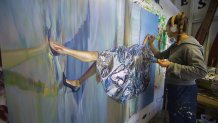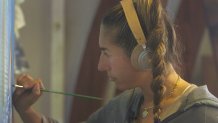Working before the canvas in her San Francisco studio, Ana Teresa Fernández was covered in self-inflicted paint. In between the gentle brush strokes on an in-progress painting, she cleaned the brush by wiping it on her pants, on her sleeve -- paint even infiltrating the headphones piping music into her head.
In an oversimplified interpretation, the scene could be taken to represent that Fernández is not afraid to get messy for her art. But her work bears that out.
To wit -- Fernández is an artist who has challenged federal authorities by painting a section of the Mexican border wall sky blue while dressed in a tango outfit -- beautified the gritty wooden walls of San Francisco cardboard collector trucks -- and created an art installation in a drug-infested neighborhood in Cape Town, South Africa.
"For me, it’s how can you bring awareness and visibility through these actions that can be poetic?" Fernández said in between bouts of painting.
Get a weekly recap of the latest San Francisco Bay Area housing news. Sign up for NBC Bay Area’s Housing Deconstructed newsletter.
It's likely Fernández developed her artistic fearlessness growing-up in her native Tampico, Mexico -- where she noted one could be taken-out any minute by a mango falling from a tree or by crocodiles that live in the town's lake. As a kid, she learned the kind of life skills that could only come from a place like Tampico.
"If you get chased by a crocodile," she explained, "you have to run in a zig-zag because they can’t turn because their hands are so short."
In Tampico, what people lacked in means, they made up for with creativity. She recalled people using the lids from coke cans to fortify the corners of cardboard houses, employing old garage doors as walls and discarded car seats as furniture.
Local
"What’s allowed there is ingenuity," Fernández said. "People make something out of nothing."
It's understandable that the town's maker mentality would rub-off on an artist whose bold projects around the world have earned her international recognition.
Fernández was eleven-years-old when her father, a doctor, took a job in San Diego and relocated the family to the United States. In San Diego, she was exposed to life along the Tijuana border which would become a central theme in her art. In school, she met girls who waited in line every day to cross the border to attend classes in the U.S. and then return home at night.
"They would wait in line sometimes almost two hours," she said.
If her Tampico upbringing manifested in her thinking, it came out in her passion for sculptures and drawings. She was drawn to learning languages, but wasn't as enthusiastic about learning in school.
She was turned down by the universities she applied to and began taking art classes in community college. A sculpture teacher urged her to submit her work to a team from San Francisco's Art Institute visiting the area to recruit new students. She was stunned when the school not only accepted her, but also awarded her a scholarship.
Through her art, coupled with the activist spirit of the Bay Area, she began to address inequalities -- such as what she viewed as a lack of opportunities for women in her native Mexico. She employed the metaphor of the tango dancing she'd become involved with, where compression between partners is required to sustain the dance -- thus emphasizing the importance of equal contribution. As a statement, Fernández began to don her tango outfit and videotape herself doing domestic chores like ironing or sweeping. From there she created paintings from the images.

To draw attention to the inequities of the U.S.-Mexican border, she hatched a plan to "erase" a section of the border wall by painting it sky blue -- also while dressed in her tango dress and heals. She managed to not only paint a large swath of the wall, but also avoid arrest by the border patrol agents who eventually showed up.
In another border-themed project, she and her husband wrapped their heads in silver blankets -- the kind given to immigrants in border holding facilities -- and attempted to kiss.
"We could only do so for about a minute because it would start asphyxiate you," she said.
During the pandemic as people flooded to grocery stores to clean the shelves of toilet paper, Fernández instead raced to the art store to buy several large canvases which she filled with images of the space blanket project. Even as the pandemic shut down life across the world, Fernández stayed perfectly content in her studio, covering the canvases, and collaterally, herself with paint.
"I love the solitude, I love the isolation," she said flanked by a large painting of the two heads wrapped in silvery material. "I have no problem spending five to seven hours completely in silence."

In a sense Fernández' work is a tribute -- and maybe even an airing of grievances toward the city and country of her birth. Hers is a complicated relationship with a place she recalls with fondness, while also observing its shortcomings of opportunity and gender equity. She remains shackled to it both in memory and in art. Like her work clothes, her version of Tampico is covered in layers of paint, which she peels at with each project.
"I wouldn’t be who I am without having grown up there," Fernández said before returning to her canvas. "I think that growing up in Tampico, it provided me that sense of magic that I carry with me all the time."



